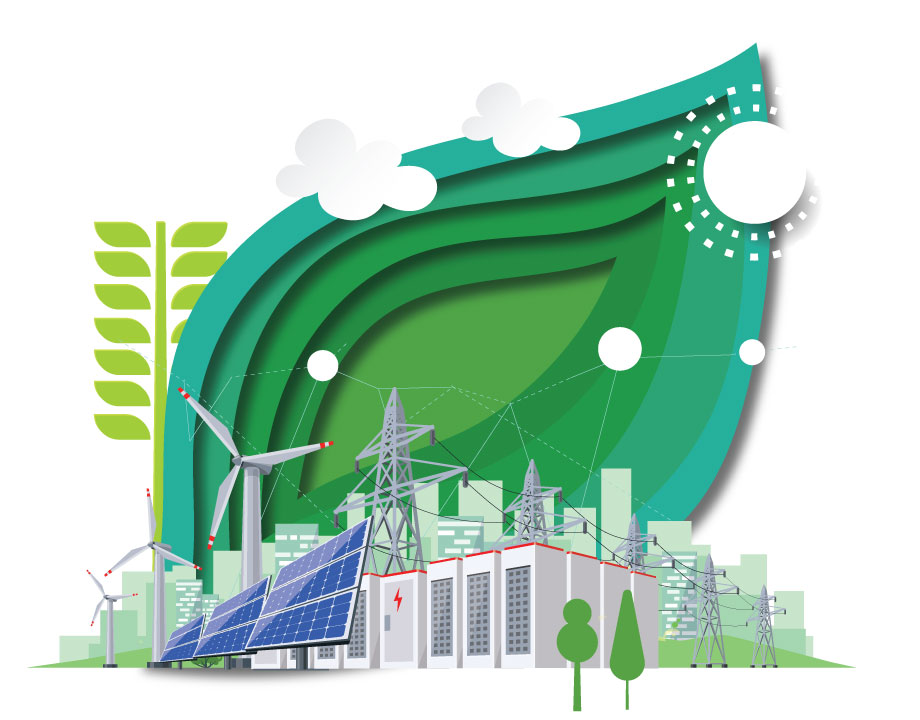Energy Blog: Crisis Gives an Unintentional Push to Green Energy
Energy Blog: Crisis Gives an Unintentional Push to Green Energy


The International Energy Agency reports the trend away from fossil fuels was accelerated by the invasion of Ukraine.
One of the first lessons of physics classes involves Isaac Newton’s laws of motion, one of which states that bodies in motion tend to continue with that motion until a force acts on them. Obviously, here in the gravity well of the Earth, there are forces at work even on stationary objects: gravity and air pressure and the normal force of the chair against the backsides. It’s when an additional force is added—the bat against a ball, say—that the motion changes direction.
That concept underlies the pronouncement in the 2022 World Energy Outlook, recently published by the International Energy Agency, the intergovernmental organization based in Paris, that the energy crisis sparked by Russia’s invasion of Ukraine earlier this year will lead to an inflection away from the use of fossil fuels.
“Energy markets and policies have changed as a result of Russia’s invasion of Ukraine, not just for the time being, but for decades to come,” said Fatih Birol, the executive director of the IEA, in a press statement on October 27. “Even with today’s policy settings, the energy world is shifting dramatically before our eyes. Government responses around the world promise to make this a historic and definitive turning point towards a cleaner, more affordable, and more secure energy system.”
Listen to the Podcast: The Strategic Importance of U.S. Gas Exports
As is inescapable to anyone who purchased gasoline or natural gas this year, the global energy system is in a crisis created by the aftermath of the Russian war in Ukraine. Gas supplies to Europe have been curtailed, first by Russia slowing flows in its gas pipelines and then by the sabotage of the Nord Stream gas pipeline to Europe. Because of Western and Central Europe’s deep dependency on Russian gas for both heating and electricity generation, world prices soared as nations there searched for alternatives.
The same was true for world oil prices, as Russian oil was excluded from many markets. According to the Federal Reserve Bank of Dallas, Russian exports once accounted for about 8 percent of the oil for sale on international markets, so removing it is like taking away a seat in a game of musical chairs.
Learn About the Advantages of ASME Membership
More quickly than anyone anticipated, however, supplies and demand began to balance out. Gas storage sites in Europe are essentially full and prices on the European futures market are down by as much as 70 percent from their peak. Oil prices haven’t come down that far, but they dropped enough that Saudi Arabia and other OPEC nations felt the need cut production to boost prices.
Regardless of the partial easing of the energy crisis, the IEA’s Outlook suggests that the instability of the past nine months is prompting consumers (and consuming nations) to re-evaluate fossil fuels from a security point of view. That’s ironic, since in recent years, as the cost of wind and solar power has plummeted, the storability and dispatchability of oil and gas has been seen as a decisive edge over intermittent renewable energy sources. If fossil fuels are subject to disruption due to geopolitical factors, just how secure are they?
More on the Energy Crisis: Are the 1970s Coming Back?
“The environmental case for clean energy needed no reinforcement, but the economic arguments in favor of cost-competitive and affordable clean technologies are now stronger–and so too is the energy security case,” Birol said. “Today’s alignment of economic, climate and security priorities has already started to move the dial towards a better outcome for the world’s people and for the planet.”
There are other factors leading to the “turning point” seen by the IEA. Energy investment is going primarily into renewable sources, and the rapid adoption of electric vehicles will soon reverse the usual increases in oil consumption. The wider deployment of energy efficiency hardware such as heat pumps can help bring down demand from the building sector. The agency sees “a definitive peak in global demand for fossil fuels. Coal demand peaks in the next few years, natural gas demand reaches a plateau by the end of the decade, and oil demand reaches a high point in the mid-2030s before falling slightly.”
More from the Energy Blog: Are Gas Utilities About to Enter a Death Spiral?
The IEA already had been forecasting a decline in fossil fuel consumption as wind and solar power became ever cheaper, electric vehicles became ever more capable, and countries made good on their pledges to zero out carbon emissions. But the Russian invasion of Ukraine altered that trajectory, according to the IEA, adding urgency. It could make a substantial difference over the next few decades.
Jeffrey Winters is editor in chief of Mechanical Engineering magazine.
That concept underlies the pronouncement in the 2022 World Energy Outlook, recently published by the International Energy Agency, the intergovernmental organization based in Paris, that the energy crisis sparked by Russia’s invasion of Ukraine earlier this year will lead to an inflection away from the use of fossil fuels.
“Energy markets and policies have changed as a result of Russia’s invasion of Ukraine, not just for the time being, but for decades to come,” said Fatih Birol, the executive director of the IEA, in a press statement on October 27. “Even with today’s policy settings, the energy world is shifting dramatically before our eyes. Government responses around the world promise to make this a historic and definitive turning point towards a cleaner, more affordable, and more secure energy system.”
Listen to the Podcast: The Strategic Importance of U.S. Gas Exports
As is inescapable to anyone who purchased gasoline or natural gas this year, the global energy system is in a crisis created by the aftermath of the Russian war in Ukraine. Gas supplies to Europe have been curtailed, first by Russia slowing flows in its gas pipelines and then by the sabotage of the Nord Stream gas pipeline to Europe. Because of Western and Central Europe’s deep dependency on Russian gas for both heating and electricity generation, world prices soared as nations there searched for alternatives.
The same was true for world oil prices, as Russian oil was excluded from many markets. According to the Federal Reserve Bank of Dallas, Russian exports once accounted for about 8 percent of the oil for sale on international markets, so removing it is like taking away a seat in a game of musical chairs.
Learn About the Advantages of ASME Membership
More quickly than anyone anticipated, however, supplies and demand began to balance out. Gas storage sites in Europe are essentially full and prices on the European futures market are down by as much as 70 percent from their peak. Oil prices haven’t come down that far, but they dropped enough that Saudi Arabia and other OPEC nations felt the need cut production to boost prices.
Regardless of the partial easing of the energy crisis, the IEA’s Outlook suggests that the instability of the past nine months is prompting consumers (and consuming nations) to re-evaluate fossil fuels from a security point of view. That’s ironic, since in recent years, as the cost of wind and solar power has plummeted, the storability and dispatchability of oil and gas has been seen as a decisive edge over intermittent renewable energy sources. If fossil fuels are subject to disruption due to geopolitical factors, just how secure are they?
More on the Energy Crisis: Are the 1970s Coming Back?
“The environmental case for clean energy needed no reinforcement, but the economic arguments in favor of cost-competitive and affordable clean technologies are now stronger–and so too is the energy security case,” Birol said. “Today’s alignment of economic, climate and security priorities has already started to move the dial towards a better outcome for the world’s people and for the planet.”
There are other factors leading to the “turning point” seen by the IEA. Energy investment is going primarily into renewable sources, and the rapid adoption of electric vehicles will soon reverse the usual increases in oil consumption. The wider deployment of energy efficiency hardware such as heat pumps can help bring down demand from the building sector. The agency sees “a definitive peak in global demand for fossil fuels. Coal demand peaks in the next few years, natural gas demand reaches a plateau by the end of the decade, and oil demand reaches a high point in the mid-2030s before falling slightly.”
More from the Energy Blog: Are Gas Utilities About to Enter a Death Spiral?
The IEA already had been forecasting a decline in fossil fuel consumption as wind and solar power became ever cheaper, electric vehicles became ever more capable, and countries made good on their pledges to zero out carbon emissions. But the Russian invasion of Ukraine altered that trajectory, according to the IEA, adding urgency. It could make a substantial difference over the next few decades.
Jeffrey Winters is editor in chief of Mechanical Engineering magazine.



